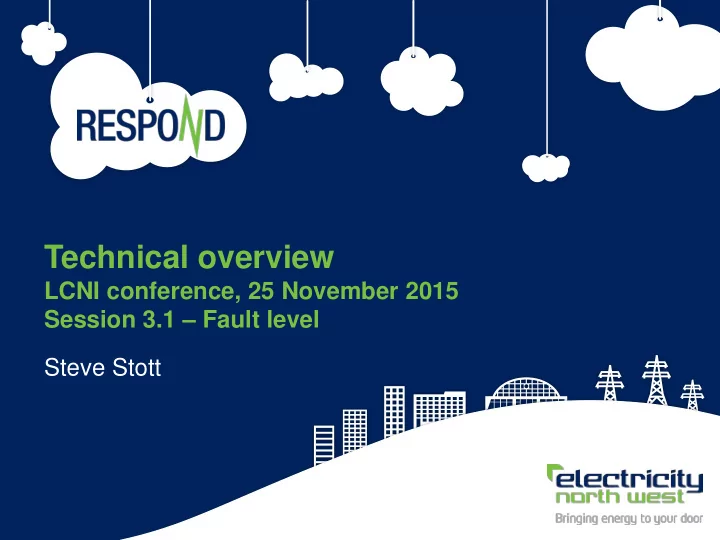

Technical overview LCNI conference, 25 November 2015 Session 3.1 – Fault level Steve Stott 1
Introduction Background The Respond project Learning to date More Information 2
Fault level challenge Traditionally network is LCTs will increase the need to Balance between load and reinforced when load or fault reinforce due to fault level fault current reinforcement current limits are reached issues expected to change Time-consuming and Need to improve fault current Need cost effective, safe expensive reinforcement could prediction capabilities alternatives constrain LCT connection 3
Fault current and the Respond project The commercial When a fault occurs Respond is an Combination of technique is known on the network alternative innovative as the ‘ Fault there is a sudden approach to technology and Current Limiting surge of current, managing commercial service’ much larger than ‘fault level’ – the techniques normal current, maximum amount Offers financial More cost-effective known as of potential fault benefits to than traditional ‘fault current’ current customers methods 4
Fault level NETWORK RECONFIGURATION Fault level reinforcement is disruptive, lengthy and expensive which can discourage connection of new demand/generation How can we manage these issues without expensive reinforcement ? 5
Sources of fault current To reduce fault level we need to disconnect sources of fault current Large Generator motor If spinning when a fault occurs, Designed for generation of electricity eg momentum of motor and magnetic field power station, CHP plant, windfarm cause electricity to flow towards the fault Fault current depends on size of generator and distance from the fault Larger sources will contribute more In the future, number of local generators near the fault will increase 6
Respond system overview REAL TIME ASSESSMENT TOOL RATING POTENTIAL FAULT CURRENT Near real time fault current assessment Safe network operation 7
Adaptive Protection Network already designed to break fault current Adaptive protection changes the order in which circuit breakers operate to safely disconnect the fault Using redundancy in the network ensures no other customers go off supply 8
Adaptive Protection learning Standard AP retrofit scheme to be fitted at primary due to legacy issues Instantaneous protection to be time delayed to allow bus section circuit breaker to open and reduce fault level 33kV AP requires more complex AC scheme design than 11kV Use interposing CTs to reduce risk and effects on existing overcurrent protection 9
I S limiters Operates within 5 milliseconds or 1/200 th of a second Detects rapid rise in current when a fault occurs and responds to break the current Respond will prove the technology, review safety case and deploy at two sites 10
I S limiter learning Designed to initiate operation in 1ms and clear fault in 3ms Uses rate of change of current and current level together to initiate trip Trip value changes implemented by ABB only Container with separate bypass CB container increases number of sites where I S limiter can be installed 11
Fault Current Limiting (FCL) service Fault current generated by customers can be disconnected using new technology Financial benefits to customers taking part and long term to all customers Challenge is to identify customers to take part in a trial of the FCL service 12
Fault Current Limiting Service learning Customers may confuse FCLS with STOR market Customers’ engineers often unfamiliar with concept of fault level Customers’ sites unlikely to have ready access to DNO SCADA Customers concerned what impact FCLS may have on their operations 13
Fault Level Assessment Tool learning Failsafe periodic Fault level study after ‘hold off’ feature any operational network required to topology change AP/FCLS/I S limiters 14
QUESTIONS & ANSWERS 15
For more information on Respond www.enwl.co.uk/respond www.enwl.co.uk/respond-survey www.enwl.co.uk/respond-videos e futurenetworks@enwl.co.uk 0800 195 4141 Thank you for your time and attention 16
Recommend
More recommend